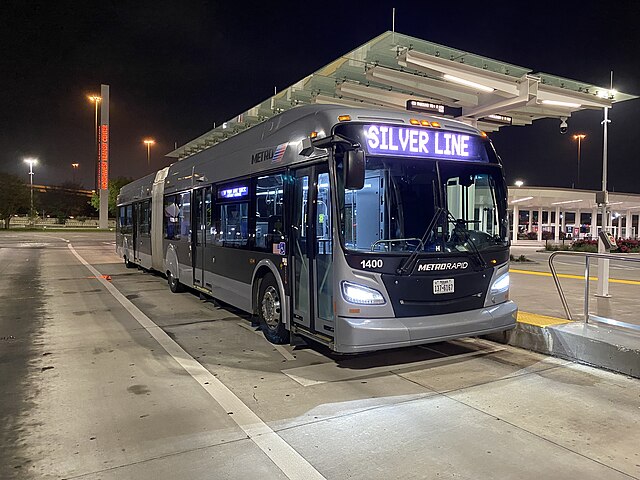A Houston bus rapid transit route over dedicated bus lanes is attracting less than 10 percent of the riders that were projected for it. The Silver Line opened in August 2020 with the expectation that it would carry 14,850 weekday riders, but in fact it is carrying less than 900 riders per weekday, about 6 percent of projections.
A Houston Silver Line sits empty, which is not unusual for it even when in motion. Photo by Ricky Courtney.
Metro, Houston’s transit agency, originally wanted to put a light-rail line in the Silver Line corridor, but opposition from local residents led it to “downgrade” the line to bus rapid transit. According to Houston businessman Bill King, Metro still managed to spend $200 million on the 4.7-mile route, mostly through tax-increment financing. This was a lot less than the $500 million or so that light rail would have cost but still a lot more than necessary.
When it was first planned, Metro projected it would carry 18,500 riders per weekday, but as is typical for many such projects the agency later reduced that estimate. Not by enough, however, as the latest ridership data indicate that the line isn’t coming close to either number. Numbers from the 2021 National Transit Database indicate that it carried 704 weekday riders in its first year of operation, and as of May 2023, ridership had increased by only about 25 percent.
Of course, the pandemic would be expected to reduce ridership. But Houston transit ridership is doing better than average, reaching 78 percent of pre-pandemic levels in May 2023. Silver Line sure isn’t reaching 78 percent of pre-pandemic projections.
One reason why ridership is low is that the line is slow. Schedules say that it takes 27 minutes to go 4.7 miles, which is an average of 10.4 miles per hour. The city’s regular local buses go much faster than that. Metro must have missed the memo that setting aside dedicated lanes to bus rapid transit is supposed to make the buses go faster, not slower.
This is just another example of why transit agencies shouldn’t spend hundreds of millions or billions of dollars on fixed transit infrastructure. No one can accurately foresee future transportation patterns, so relying on forms of transit that can be kept flexible — meaning buses sharing lanes with other traffic — is the safest and most cost-effective way to go.









Then typical excuse
Car-centric
Subsidies
blah blah blah….
In any case traditionally designed neighborhoods and towns still wouldn’t solicit frequent use.
Transit follows job concentrations. When the first streetcars were built they connected to city centers for downtown employees. When streetcar suburbs were founded, streetcars moved populaces to city centers.
When Automobiles were invented, cities depopulated because external forces to move working class people out of the festid claptraps and terrible living condition tenements. But people still commuted to city for work.
Once companies established satellite offices and networked communications (Phones….fax and later internet) cities no longer became functionally relevant.
Vertical manufacturing was replaced by horizontal manufacturing. A few companies tried rekindle vertically integrated manufacture (American Apparel) in City metros.
Once instance, is low rise buildings exceeding 3 stories, No such building has been built in last 100 years, Because modern safety/fire codes discourage building anything bigger 3 stories out of wood. Anything higher, built from masonry blocks, concrete or steel which increases the price. On other hand, Modular materials lower building prices. Take Boston’s Big Dig building. Made from remnants prefabricated truss assemblies of Temporary highway support.
https://images.adsttc.com/media/images/55f6/ea8e/adbc/0116/5400/01db/newsletter/bikepath-west.jpg?1442245235
In any case, Automotive transit is not new. which is why government runs interference to thwart it
Looks like they built the part of the line with the least potential first.
Kinda like Honolulu.
Kinda like Cali.